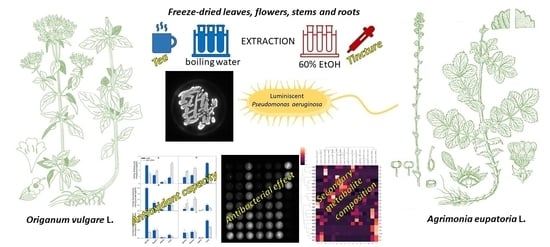Effect of Agrimonia eupatoria L. and Origanum vulgare L. Leaf, Flower, Stem, and Root Extracts on the Survival of Pseudomonas aeruginosa
Abstract
1. Introduction
2. Results
2.1. Total Phenolics, Flavonoids, and Antioxidant Capacity of A. eupatoria and O. vulgare
2.2. Antimicrobial Activity of A. eupatoria and O. vulgare Water and Ethanolic Extracts against P. aeruginosa
2.3. Determination of MIC50 Values for A. eupatoria and O. vulgare Water and Ethanolic Extracts
2.4. Correlation Analysis between Plant Characteristics and P. aeruginosa Viability
2.5. Identification of Phenolic Compounds in A. eupatoria and O. vulgare Water and Ethanolic Extracts
3. Discussion
4. Materials and Methods
4.1. Plant Extracts
4.2. Total Phenolics and Flavonoids
4.3. Antioxidant Capacity
4.4. Analysis of Secondary Metabolites
4.5. Microorganism Strain and Culture Conditions
4.6. Determination of Antimicrobial Activity
4.7. Statistics
5. Conclusions
Supplementary Materials
Author Contributions
Funding
Institutional Review Board Statement
Informed Consent Statement
Data Availability Statement
Acknowledgments
Conflicts of Interest
References
- Álvarez-Martínez, F.; Barrajón-Catalán, E.; Herranz-López, M.; Micol, V. Antibacterial plant compounds, extracts and essential oils: An updated review on their effects and putative mechanisms of action. Phytomedicine 2021, 90, 153626. [Google Scholar] [CrossRef]
- Kiokias, S.; Proestos, C.; Oreopoulou, V. Phenolic Acids of Plant Origin—A Review on Their Antioxidant Activity In Vitro (O/W Emulsion Systems) Along with Their in Vivo Health Biochemical Properties. Foods 2020, 9, 534. [Google Scholar] [CrossRef]
- Bartwal, A.; Mall, R.; Lohani, P.; Guru, S.K.; Arora, S. Role of Secondary Metabolites and Brassinosteroids in Plant Defense Against Environmental Stresses. J. Plant Growth Regul. 2013, 32, 216–232. [Google Scholar] [CrossRef]
- Tupec, M.; Hýsková, V.; Bělonožníková, K.; Hraníček, J.; Červený, V.; Ryšlavá, H. Characterization of some potential medicinal plants from Central Europe by their antioxidant capacity and the presence of metal elements. Food Biosci. 2017, 20, 43–50. [Google Scholar] [CrossRef]
- Ghaima, K.K. Antibacterial and wound healing activity of some Agrimonia eupatoria extracts. J. Baghdad Sci. 2013, 10, 152–160. [Google Scholar]
- Pour, M.G.; Mirazi, N.; Moradkhani, S.; Rafieian-Kopaei, M.; Rahimi-Madiseh, M. A comprehensive review on phytochemical, pharmacological and therapeutic properties of Agrimonia eupatoria L. J. Herbmed. Pharmacol. 2021, 10, 14–30. [Google Scholar] [CrossRef]
- Bora, L.; Avram, S.; Pavel, I.Z.; Muntean, D.; Liga, S.; Buda, V.; Gurgus, D.; Danciu, C. An Up-To-Date Review Regarding Cutaneous Benefits of Origanum vulgare L. Essential Oil. Antibiotics 2022, 11, 549. [Google Scholar] [CrossRef]
- Soltani, S.; Shakeri, A.; Iranshahi, M.; Boozari, M. A Review of the Phytochemistry and Antimicrobial Properties of Origanum vulgare L. and Subspecies. Iran J. Pharm. Res. 2021, 20, 268–285. [Google Scholar] [CrossRef]
- Lombrea, A.; Antal, D.; Ardelean, F.; Avram, S.; Pavel, I.Z.; Vlaia, L.; Mut, A.-M.; Diaconeasa, Z.; Dehelean, C.A.; Soica, C.; et al. A Recent Insight Regarding the Phytochemistry and Bioactivity of Origanum vulgare L. Essential Oil. Int. J. Mol. Sci. 2020, 21, 9653. [Google Scholar] [CrossRef]
- De Mastro, G.; Tarraf, W.; Verdini, L.; Brunetti, G.; Ruta, C. Essential oil diversity of Origanum vulgare L. populations from Southern Italy. Food Chem. 2017, 235, 1–6. [Google Scholar] [CrossRef]
- Fikry, S.; Khalil, N.; Salama, O. Chemical profiling, biostatic and biocidal dynamics of Origanum vulgare L. essential oil. AMB Express 2019, 9, 41. [Google Scholar] [CrossRef]
- Feng, X.-L.; He, Y.-B.; Liang, Y.-Z.; Wang, Y.-L.; Huang, L.-F.; Xie, J.-W. Comparative Analysis of the Volatile Components of Agrimonia eupatoria from Leaves and Roots by Gas Chromatography-Mass Spectrometry and Multivariate Curve Resolution. J. Anal. Methods Chem. 2013, 2013, 246986. [Google Scholar] [CrossRef]
- Alekseeva, M.; Zagorcheva, T.; Atanassov, I.; Rusanov, K. Origanum vulgare L.—A review on genetic diversity, cultivation, biological activities and perspectives for molecular breeding. Bulg. J. Agric. Sci. 2020, 26, 1183–1197. [Google Scholar]
- Guo, X.; Hao, Y.; Zhang, W.; Xia, F.; Bai, H.; Li, H.; Shi, L. Comparison of Origanum Essential Oil Chemical Compounds and Their Antibacterial Activity against Cronobacter sakazakii. Molecules 2022, 27, 6702. [Google Scholar] [CrossRef]
- Scandorieiro, S.; Rodrigues, B.C.D.; Nishio, E.K.; Panagio, L.A.; de Oliveira, A.G.; Durán, N.; Nakazato, G.; Kobayashi, R.K.T. Biogenic Silver Nanoparticles Strategically Combined with Origanum vulgare Derivatives: Antibacterial Mechanism of Action and Effect on Multidrug-Resistant Strains. Front. Microbiol. 2022, 13, 842600. [Google Scholar] [CrossRef]
- Ivanova, D.; Vankova, D.; Nashar, M. Agrimonia eupatoriatea consumption in relation to markers of inflammation, oxidative status and lipid metabolism in healthy subjects. Arch. Physiol. Biochem. 2013, 119, 32–37. [Google Scholar] [CrossRef]
- Cho, Y.M.; Kwon, J.E.; Lee, M.; Lea, Y.; Jeon, D.-Y.; Kim, H.J.; Kang, S.C. Agrimonia eupatoria L. (Agrimony) Extract Alters Liver Health in Subjects with Elevated Alanine Transaminase Levels: A Controlled, Randomized, and Double-Blind Trial. J. Med. Food 2018, 21, 282–288. [Google Scholar] [CrossRef]
- Mouro, C.; Dunne, C.P.; Gouveia, I.C. Designing New Antibacterial Wound Dressings: Development of a Dual Layer Cotton Material Coated with Poly(Vinyl Alcohol)_Chitosan Nanofibers Incorporating Agrimonia eupatoria L. Extract. Molecules 2020, 26, 83. [Google Scholar] [CrossRef]
- Muruzović, M.; Mladenović, K.G.; Stefanović, O.D.; Vasić, S.M.; Čomić, L.R. Extracts of Agrimonia eupatoria L. as sources of biologically active compounds and evaluation of their antioxidant, antimicrobial, and antibiofilm activities. J. Food Drug Anal. 2016, 24, 539–547. [Google Scholar] [CrossRef]
- Komiazyk, M.; Palczewska, M.; Sitkiewicz, I.; Pikula, S.; Groves, P. Neutralization of cholera toxin by Rosaceae family plant extracts. BMC Complement. Altern. Med. 2019, 19, 140. [Google Scholar] [CrossRef]
- Watkins, F.; Pendry, B.; Sanchez-Medina, A.; Corcoran, O. Antimicrobial assays of three native British plants used in Anglo-Saxon medicine for wound healing formulations in 10th century England. J. Ethnopharmacol. 2012, 144, 408–415. [Google Scholar] [CrossRef]
- Malhotra, S.; Hayes, D., Jr.; Wozniak, D.J. Cystic Fibrosis and Pseudomonas aeruginosa: The Host-Microbe Interface. Clin. Microbiol. Rev. 2019, 32, e00138-18. [Google Scholar] [CrossRef]
- Law, N.; Logan, C.; Yung, G.; Furr, C.-L.L.; Lehman, S.M.; Morales, S.; Rosas, F.; Gaidamaka, A.; Bilinsky, I.; Grint, P.; et al. Successful adjunctive use of bacteriophage therapy for treatment of multidrug-resistant Pseudomonas aeruginosa infection in a cystic fibrosis patient. Infection 2019, 47, 665–668. [Google Scholar] [CrossRef]
- Lewenza, S.; Falsafi, R.K.; Winsor, G.; Gooderham, W.J.; McPhee, J.B.; Brinkman, F.S.; Hancock, R.E. Construction of a mini-Tn5-luxCDABE mutant library in Pseudomonas aeruginosa PAO1: A tool for identifying differentially regulated genes. Genome Res. 2005, 15, 583–589. [Google Scholar] [CrossRef]
- Hilpert, K.; Hancock, R.E.W. Use of luminescent bacteria for rapid screening and characterization of short cationic antimicrobial peptides synthesized on cellulose using peptide array technology. Nat. Protoc. 2007, 2, 1652–1660. [Google Scholar] [CrossRef]
- Waskom, M.L. seaborn: Statistical data visualization. J. Open Source Softw. 2021, 6, 3021. [Google Scholar] [CrossRef]
- Balouiri, M.; Sadiki, M.; Ibnsouda, S.K. Methods for in vitro evaluating antimicrobial activity: A review. J. Pharm. Anal. 2016, 6, 71–79. [Google Scholar] [CrossRef]
- Thorn, R.M.; Nelson, S.M.; Greenman, J. Use of a bioluminescent Pseudomonas aeruginosa strain within an in vitro microbiological system, as a model of wound infection, to assess the antimicrobial efficacy of wound dressings by monitoring light production. Antimicrob. Agents Chemother. 2007, 51, 3217–3224. [Google Scholar] [CrossRef]
- Ippolito, A.; Nigro, F. Natural antimicrobials for preserving fresh fruit and vegetables. In Improving the Safety of Fresh Fruit and Vegetables; Jongen, W., Ed.; Woodhead Publishing: Sawston, UK, 2005; pp. 513–555. [Google Scholar] [CrossRef]
- Lu, M.; Dai, T.; Murray, C.K.; Wu, M.X. Bactericidal Property of Oregano Oil against Multidrug-Resistant Clinical Isolates. Front. Microbiol. 2018, 9, 2329. [Google Scholar] [CrossRef]
- Elansary, H.O.; Abdelgaleil, S.A.M.; Mahmoud, E.A.; Yessoufou, K.; Elhindi, K.; El-Hendawy, S. Effective antioxidant, antimicrobial and anticancer activities of essential oils of horticultural aromatic crops in northern Egypt. BMC Complement. Altern. Med. 2018, 18, 214. [Google Scholar] [CrossRef] [PubMed]
- Béjaoui, A.; Chaabane, H.; Jemli, M.; Boulila, A.; Boussaid, M. Essential Oil Composition and Antibacterial Activity of Origanum vulgare subsp. glandulosum Desf. at Different Phenological Stages. J. Med. Food 2013, 16, 1115–1120. [Google Scholar] [CrossRef]
- Zkalp, B.; Sevgi, F.; Özcan, M.; Özcan, M.M. The antibacterial activity of essential oil of oregano (Origanum vulgare L.). J. Food Agric. Environ. 2010, 8, 272–274. [Google Scholar]
- Bouarab-Chibane, L.; Forquet, V.; Lantéri, P.; Clément, Y.; Léonard-Akkari, L.; Oulahal, N.; Degraeve, P.; Bordes, C. Antibacterial Properties of Polyphenols: Characterization and QSAR (Quantitative Structure–Activity Relationship) Models. Front. Microbiol. 2019, 10, 829. [Google Scholar] [CrossRef]
- Negi, P.S. Plant extracts for the control of bacterial growth: Efficacy, stability and safety issues for food application. Int. J. Food Microbiol. 2012, 156, 7–17. [Google Scholar] [CrossRef]
- Naveed, M.; Hejazi, V.; Abbas, M.; Kamboh, A.A.; Khan, G.J.; Shumzaid, M.; Ahmad, F.; Babazadeh, D.; FangFang, X.; Modarresi-Ghazani, F.; et al. Chlorogenic acid (CGA): A pharmacological review and call for further research. Biomed. Pharmacother. 2018, 97, 67–74. [Google Scholar] [CrossRef]
- Dziedzinski, M.; Kobus-Cisowska, J.; Szymanowska, D.; Stuper-Szablewska, K.; Baranowska, M. Identification of Polyphenols from Coniferous Shoots as Natural Antioxidants and Antimicrobial Compounds. Molecules 2020, 25, 3527. [Google Scholar] [CrossRef]
- Bajko, E.; Kalinowska, M.; Borowski, P.; Siergiejczyk, L.; Lewandowski, W. 5-O-Caffeoylquinic acid: A spectroscopic study and biological screening for antimicrobial activity. LWT-Food Sci. Technol. 2016, 65, 471–479. [Google Scholar] [CrossRef]
- Fu, L.; Lu, W.; Zhou, X. Phenolic Compounds and In Vitro Antibacterial and Antioxidant Activities of Three Tropic Fruits: Persimmon, Guava, and Sweetsop. BioMed Res. Int. 2016, 2016, 4287461. [Google Scholar] [CrossRef]
- Karunanidhi, A.; Thomas, R.; van Belkum, A.; Neela, V. In Vitro Antibacterial and Antibiofilm Activities of Chlorogenic Acid against Clinical Isolates of Stenotrophomonas maltophilia including the Trimethoprim/Sulfamethoxazole Resistant Strain. BioMed Res. Int. 2013, 2013, 392058. [Google Scholar] [CrossRef]
- Engels, C.; Schieber, A.; Gänzle, M.G. Sinapic acid derivatives in defatted Oriental mustard (Brassica juncea L.) seed meal extracts using UHPLC-DAD-ESI-MS n and identification of compounds with antibacterial activity. Eur. Food Res. Technol. 2012, 234, 535–542. [Google Scholar] [CrossRef]
- Chen, C. Sinapic Acid and Its Derivatives as Medicine in Oxidative Stress-Induced Diseases and Aging. J. Oxid. Med. Cell. Longev. 2016, 2016, 3571614. [Google Scholar] [CrossRef] [PubMed]
- Nguyen, T.L.A.; Bhattacharya, D. Antimicrobial Activity of Quercetin: An Approach to Its Mechanistic Principle. Molecules 2022, 27, 2494. [Google Scholar] [CrossRef] [PubMed]
- Arima, H.; Ashida, H.; Danno, G.-I. Rutin-enhanced Antibacterial Activities of Flavonoids against Bacillus cereus and Salmonella enteritidis. Biosci. Biotechnol. Biochem. 2002, 66, 1009–1014. [Google Scholar] [CrossRef]
- Xie, Y.; Chen, J.; Wang, B.; Peng, A.-Y.; Mao, Z.-W.; Xia, W. Inhibition of Quorum-Sensing Regulator from Pseudomonas aeruginosa Using a Flavone Derivative. Molecules 2022, 27, 2439. [Google Scholar] [CrossRef]
- Lou, Z.; Wang, H.; Rao, S.; Sun, J.; Ma, C.; Li, J. p-Coumaric acid kills bacteria through dual damage mechanisms. Food Control. 2012, 25, 550–554. [Google Scholar] [CrossRef]
- Bai, J.; Wu, Y.; Bu, Q.; Zhong, K.; Gao, H. Comparative study on antibacterial mechanism of shikimic acid and quinic acid against Staphylococcus aureus through transcriptomic and metabolomic approaches. Lwt 2021, 153, 112441. [Google Scholar] [CrossRef]
- Hýsková, V.; Bělonožníková, K.; Šmeringaiová, I.; Kavan, D.; Ingr, M.; Ryšlavá, H. How is the activity of shikimate dehydrogenase from the root of Petroselinum crispum (parsley) regulated and which side reactions are catalyzed? Phytochemistry 2021, 190, 112881. [Google Scholar] [CrossRef] [PubMed]
- Ajiboye, T.O.; Habibu, R.S.; Saidu, K.; Haliru, F.Z.; Ajiboye, H.O.; Aliyu, N.O.; Ibitoye, O.B.; Uwazie, J.N.; Muritala, H.F.; Bello, S.A.; et al. Involvement of oxidative stress in protocatechuic acid-mediated bacterial lethality. Microbiologyopen 2017, 6, e00472. [Google Scholar] [CrossRef]
- Herald, T.J.; Gadgil, P.; Tilley, M. High-throughput micro plate assays for screening flavonoid content and DPPH-scavenging activity in sorghum bran and flour. J. Sci. Food Agric. 2012, 92, 2326–2331. [Google Scholar] [CrossRef]
- Agut, B.; Gamir, J.; Jacas, J.A.; Hurtado, M.; Flors, V. Different metabolic and genetic responses in citrus may explain relative susceptibility to Tetranychus urticae. Pest Manag. Sci. 2014, 70, 1728–1741. [Google Scholar] [CrossRef]
- Hýsková, V.; Bělonožníková, K.; Doričová, V.; Kavan, D.; Gillarová, S.; Henke, S.; Synková, H.; Ryšlavá, H.; Čeřovská, N. Effects of heat treatment on metabolism of tobacco plants infected with Potato virus Y. Plant Biol. 2021, 23, 131–141. [Google Scholar] [CrossRef]
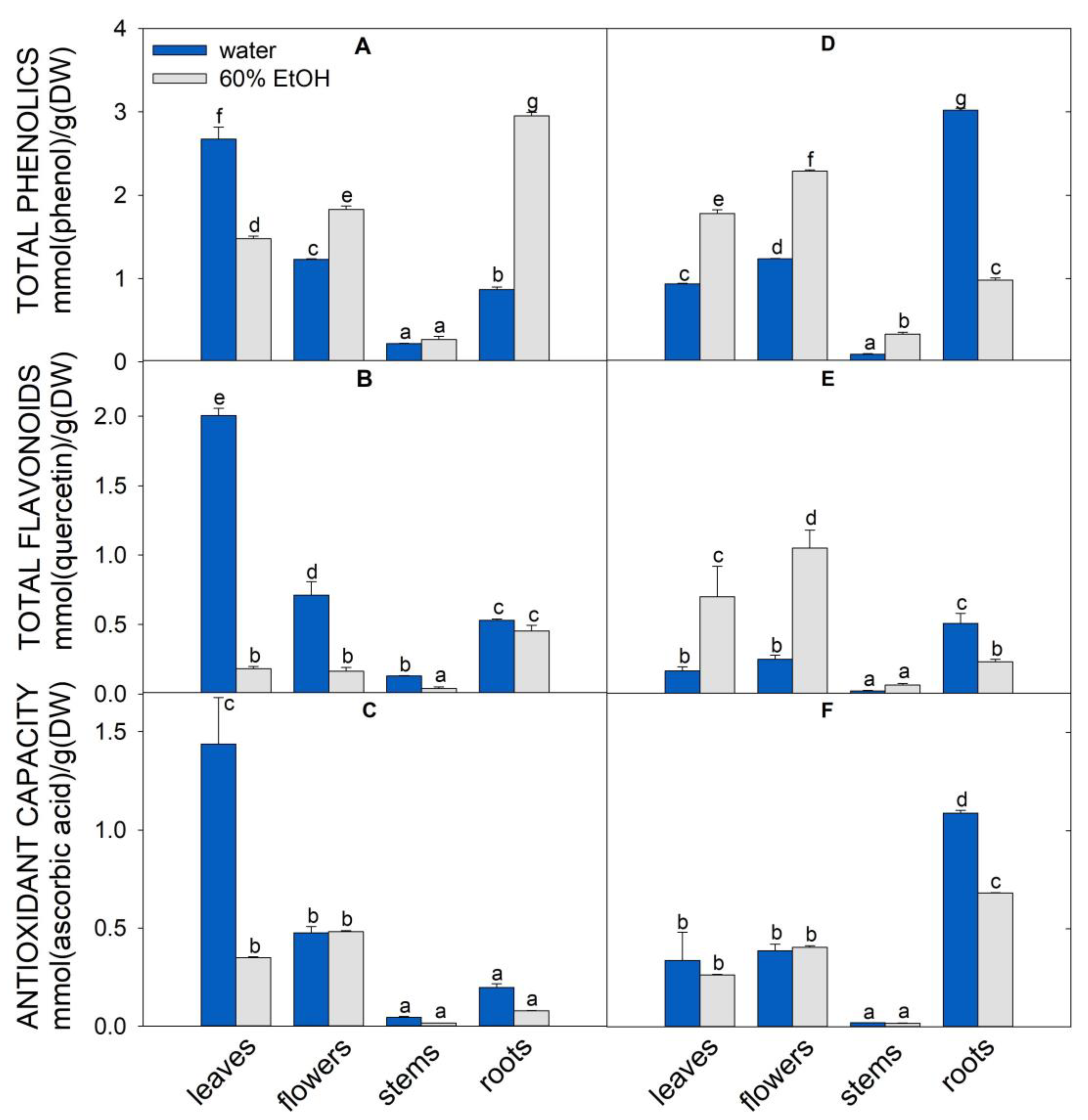
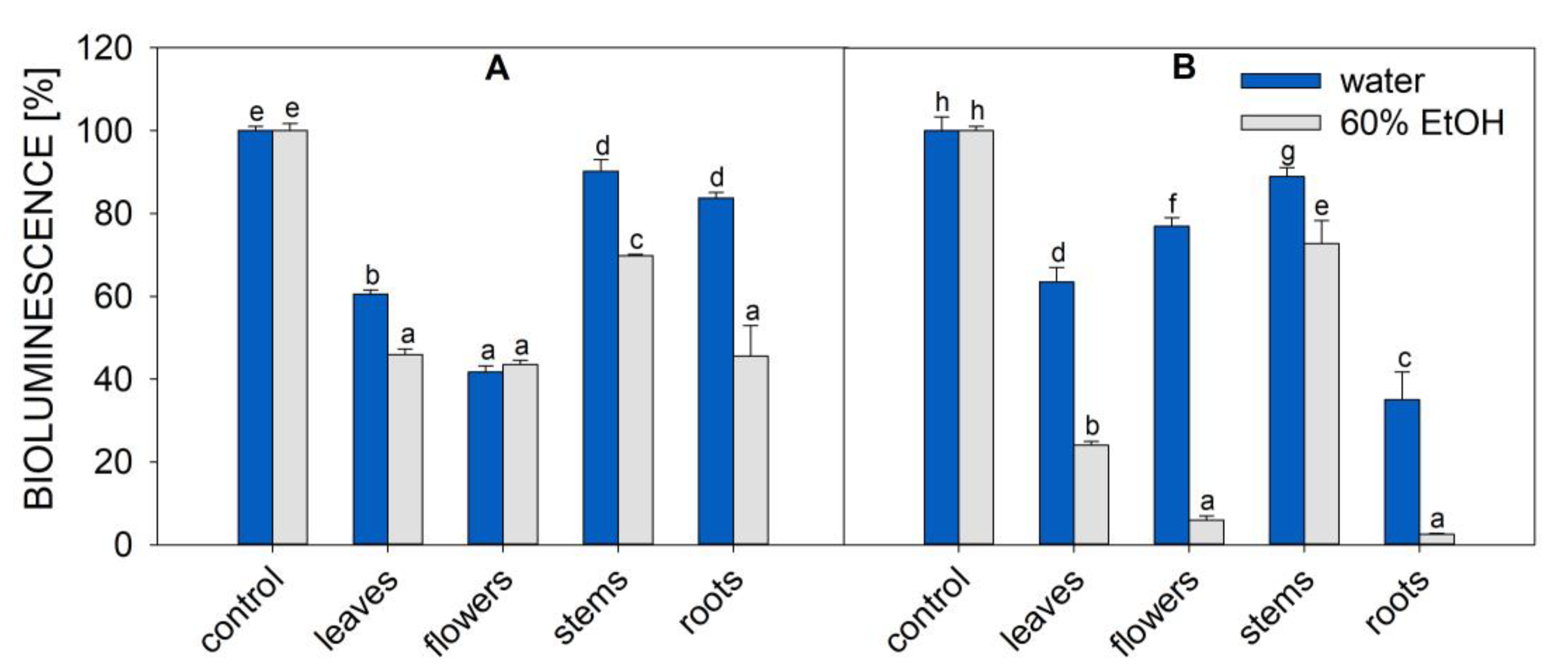
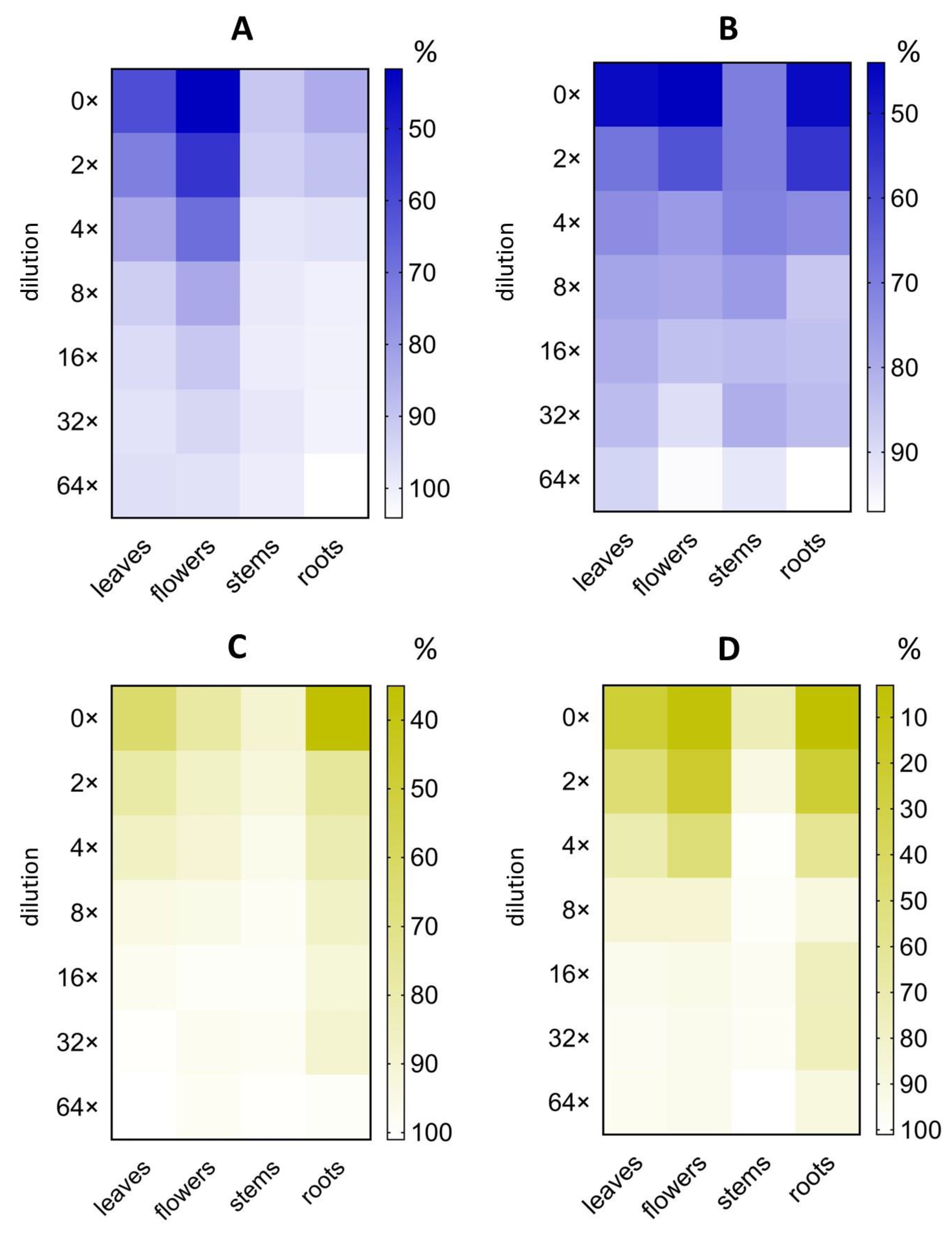
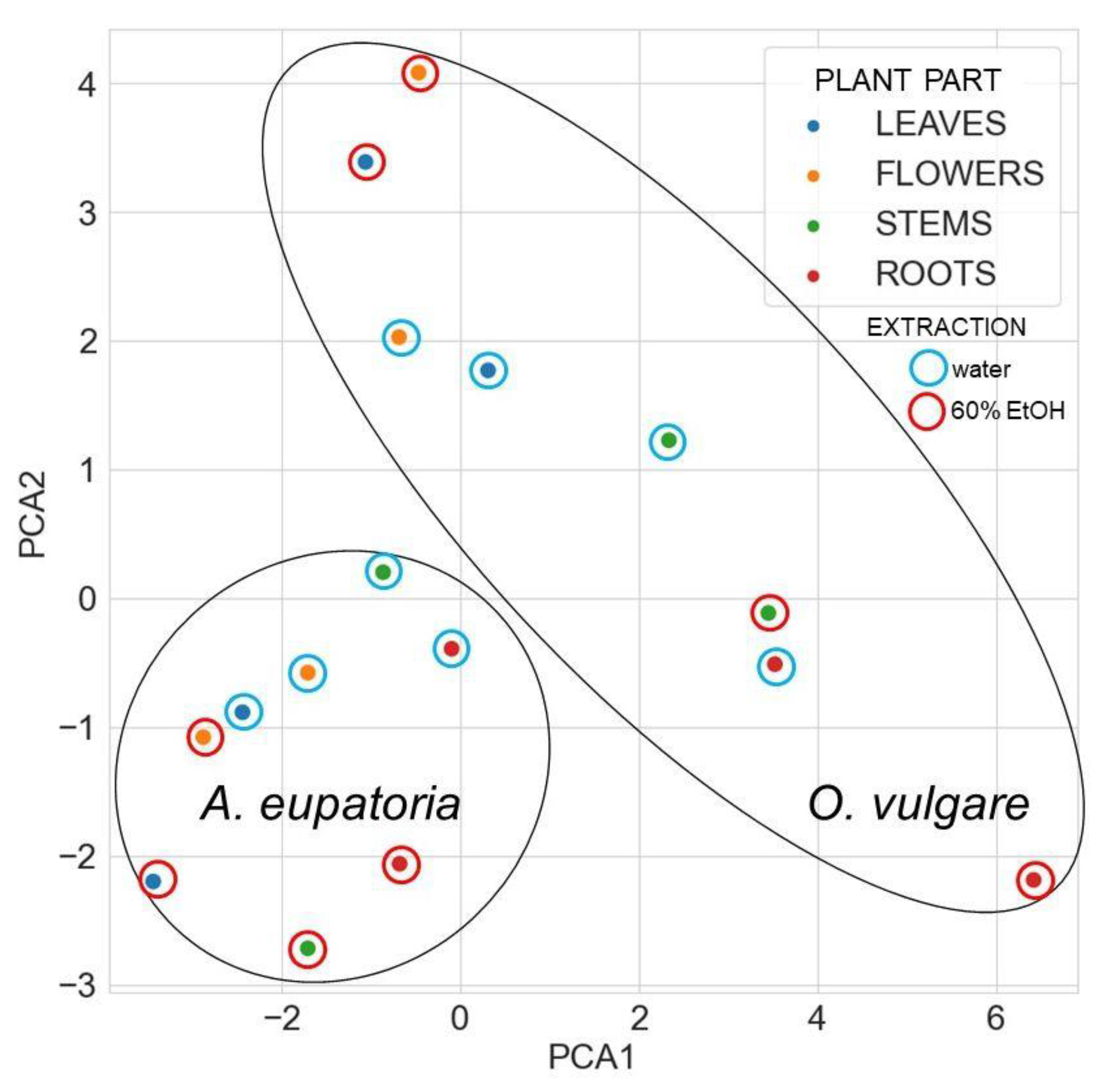
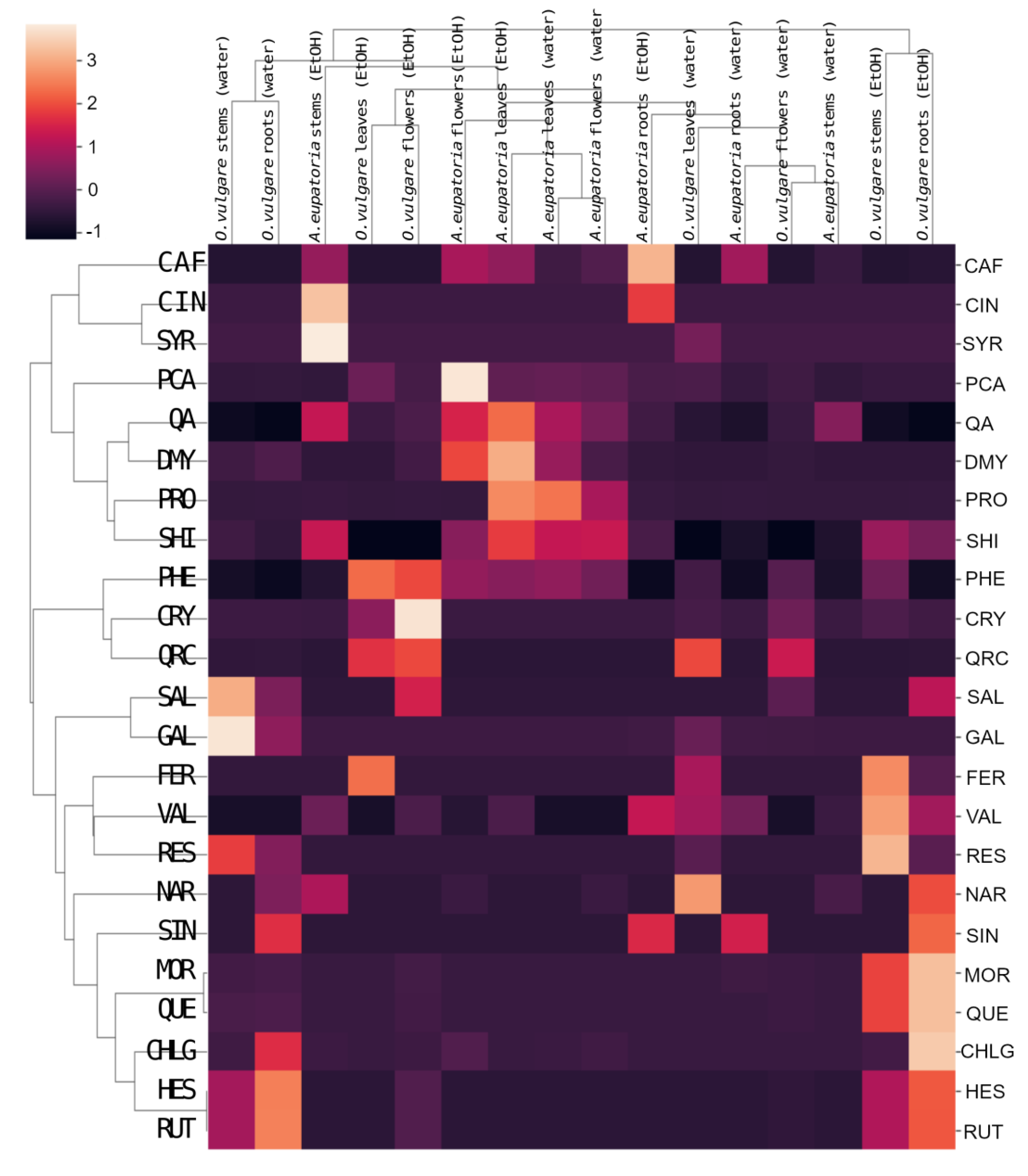
| Plant/Extraction Method | Plant Part | MIC50 (Lyophilizate) [mg/mL] | MIC50 (Evaporate) [mg/mL] |
|---|---|---|---|
| A. eupatoria water extract | flowers | 10 | 17.7 ± 2.6 |
| leaves | 15 | 16.7 ± 0.0 | |
| stems | 21 | 10.1 ± 3.6 | |
| roots | 20 | 16.5 ± 0.0 | |
| A. eupatoria 60% ethanolic extract | flowers | 52 | 24.1 ± 2.7 |
| leaves | 55 | 19.7 ± 3.0 | |
| stems | 83 | 14.3 ± 0.4 | |
| roots | 55 | 17.3 ± 0.0 | |
| O. vulgare water extract | flowers | 18 | 10.2 ± 2.7 |
| leaves | 15 | 18.2 ± 0.0 | |
| stems | 21 | 7.1 ± 1.7 | |
| roots | 8 | 12.4 ± 0.1 | |
| O. vulgare 60% ethanolic extract | flowers | 7 | 4.5 ± 0.0 |
| leaves | 29 | 14.6 ± 1.2 | |
| stems | 87 | 28.5 ± 0.7 | |
| roots | 4 | 2.3 ± 0.4 |
| nmol/g (Dry Weight) | |||||||||||||||||||||||||
|---|---|---|---|---|---|---|---|---|---|---|---|---|---|---|---|---|---|---|---|---|---|---|---|---|---|
| Plant | Part | Extraction | CAF | CHLG | CIN | CRY | DMY | FER | GAL | HES | MOR | NAR | PCA | PHE | PRO | QA | QRC | QUE | RES | RUT | SAL | SHI | SIN | SYR | VAL |
| A. eupatoria | leaves | water | 419 ± 0 | 10 ± 0 | <LOD | <LOD | 24 ± 4 | <LOD | <LOD | <LOD | <LOD | <LOD | 111 ± 4 | 179 ± 17 | 49480 ± 0 | 2530 ± 0 | <LOD | <LOD | <LOD | <LOD | <LOD | 161 ± 0 | <LOD | <LOD | <LOD |
| flowers | 708 ± 0 | 28 ± 0 | <LOD | <LOD | 6 ± 1 | <LOD | <LOD | <LOD | <LOD | 1 ± 0 | 89 ± 3 | 148 ± 8 | 24070 ± 0 | 1903 ± 173 | <LOD | <LOD | <LOD | <LOD | <LOD | 179 ± 3 | <LOD | <LOD | <LOD | ||
| stems | 338 ± 0 | 3 ± 0 | <LOD | <LOD | <LOD | <LOD | <LOD | <LOD | <LOD | 2 ± 0 | <LOD | 37 ± 0 | 52 ± 1 | 2023 ± 107 | <LOD | <LOD | <LOD | <LOD | <LOD | 31 ± 1 | <LOD | <LOD | 14 ± 4 | ||
| roots | 1870 ± 0 | 3 ± 0 | <LOD | <LOD | <LOD | <LOD | 20 ± 0 | <LOD | 2.2 ± 0 | <LOD | 8 ± 0 | 21 ± 0 | 106 ± 1 | 469 ± 56 | <LOD | <LOD | <LOD | <LOD | <LOD | 34 ± 8 | 12 ± 0 | <LOD | 27 ± 2 | ||
| leaves | 60% EtOH | 333 ± 5 | <LOD | <LOD | <LOD | 15 ± 1 | <LOD | <LOD | <LOD | <LOD | <LOD | 19 ± 0 | 27 ± 10 | 10730 ± 0 | 860 ± 61 | <LOD | <LOD | <LOD | <LOD | <LOD | 41 ± 2 | <LOD | <LOD | 3 ± 0 | |
| flowers | 399 ± 6 | 17 ± 0 | <LOD | <LOD | 13 ± 2 | <LOD | <LOD | <LOD | <LOD | 0.2 ± 0.1 | 100 ± 42 | 31 ± 10 | <LOD | 665 ± 55 | <LOD | <LOD | <LOD | <LOD | <LOD | 26 ± 1 | <LOD | <LOD | 1 ± 0 | ||
| stems | 340 ± 0 | 3 ± 0 | 2 ± 0 | <LOD | <LOD | <LOD | 2 ± 0 | <LOD | <LOD | 1.5 ± 0.1 | <LOD | 10 ± 0 | 169 ± 68 | 637 ± 81 | <LOD | <LOD | <LOD | <LOD | <LOD | 28 ± 7 | <LOD | 33 ± 3 | 5 ± 0 | ||
| roots | 935 ± 0 | <LOD | 1.2 ± 0 | <LOD | 0.2 ± 0 | <LOD | 5 ± 1 | <LOD | <LOD | <LOD | 10 ± 0 | 2 ± 0 | 220 ± 0 | 203 ± 12 | <LOD | <LOD | <LOD | <LOD | <LOD | 14 ± 1 | 3 ± 0 | <LOD | 9 ± 0 | ||
| O. vulgare | leaves | water | <LOD | <LOD | <LOD | 249 ± 0 | <LOD | 5 ± 0 | 289 ± 0 | <LOD | <LOD | 16 ± 0 | 40 ± 13 | 108 ± 16 | 26 ± 6 | 732 ± 139 | 6086 ± 268 | <LOD | 3 ± 2 | <LOD | <LOD | <LOD | <LOD | 41 ± 19 | 36 ± 0 |
| flowers | <LOD | 5 ± 0 | <LOD | 1014 ± 59 | 1.3 ± 0 | <LOD | 15 ± 0 | 5 ± 0 | 1.4 ± 0 | <LOD | 27 ± 0 | 124 ± 1 | 30 ± 1 | 852 ± 19 | 5295 ± 522 | 2 ± 0 | <LOD | 5 ± 0 | 7 ± 0 | <LOD | <LOD | <LOD | <LOD | ||
| stems | <LOD | 20 ± 0 | <LOD | 24 ± 9 | 3 ± 1 | <LOD | 2224 ± 0 | 144 ± 0 | 3.7 ± 0 | <LOD | 2 ± 1 | 30 ± 0 | 6 ± 0 | 133 ± 8 | 228 ± 93 | 12 ± 0 | 6 ± 0 | 138 ± 0 | 43 ± 0 | 61 ± 0 | <LOD | <LOD | <LOD | ||
| roots | <LOD | 556 ± 0 | <LOD | 17 ± 3 | 9 ± 0 | <LOD | 439 ± 97 | 303 ± 0 | 5 ± 0 | 5 ± 0 | 5 ± 1 | 13 ± 0 | 112 ± 7 | 8 ± 0 | 183 ± 10 | 14 ± 0 | 2.5 ± 0 | 290 ± 0 | 12 ± 0 | 48 ± 0 | 13 ± 1 | <LOD | <LOD | ||
| leaves | 60% EtOH | <LOD | <LOD | <LOD | 298 ± 0 | <LOD | 2 ± 0 | <LOD | <LOD | <LOD | <LOD | 17 ± 7 | 76 ± 0 | 17 ± 0 | 149 ± 26 | 1352 ± 206 | <LOD | <LOD | <LOD | <LOD | <LOD | <LOD | <LOD | <LOD | |
| flowers | <LOD | 4 ± 0 | <LOD | 1254 ± 0 | 1 ± 0 | <LOD | <LOD | 10 ± 0 | 0.8 ± 0 | <LOD | 7 ± 1 | 68 ± 0 | 33 ± 0 | 197 ± 23 | 1215 ± 51 | 1 ± 0 | <LOD | 9 ± 0 | 5 ± 0 | <LOD | <LOD | <LOD | 3 ± 0 | ||
| stems | <LOD | 7 ± 0 | <LOD | 54 ± 18 | <LOD | 2 ± 0 | <LOD | 31 ± 0 | 15 ± 0 | <LOD | 3 ± 1 | 30 ± 0 | 8 ± 2 | 45 ± 1 | <LOD | 25 ± 0 | 1.9 | 30 ± 0 | <LOD | 17 ± 10 | <LOD | <LOD | 16 ± 0 | ||
| roots | 15 ± 0 | 208 ± 0 | <LOD | 26 ± 0 | <LOD | 0.4 ± 0 | <LOD | 53 ± 0 | 25 ± 0 | 2 ± 0 | 3 ± 1 | 4 ± 0 | 30 ± 1 | 4 ± 0 | 7 ± 0 | 40 ± 0 | 0.2 ± 0 | 50 ± 0 | 4 ± 0 | 22 ± 0 | 4 ± 0 | <LOD | 10 ± 3 | ||
Disclaimer/Publisher’s Note: The statements, opinions and data contained in all publications are solely those of the individual author(s) and contributor(s) and not of MDPI and/or the editor(s). MDPI and/or the editor(s) disclaim responsibility for any injury to people or property resulting from any ideas, methods, instructions or products referred to in the content. |
© 2023 by the authors. Licensee MDPI, Basel, Switzerland. This article is an open access article distributed under the terms and conditions of the Creative Commons Attribution (CC BY) license (https://creativecommons.org/licenses/by/4.0/).
Share and Cite
Bělonožníková, K.; Sladkovská, E.; Kavan, D.; Hýsková, V.; Hodek, P.; Šmíd, D.; Ryšlavá, H. Effect of Agrimonia eupatoria L. and Origanum vulgare L. Leaf, Flower, Stem, and Root Extracts on the Survival of Pseudomonas aeruginosa. Molecules 2023, 28, 1019. https://doi.org/10.3390/molecules28031019
Bělonožníková K, Sladkovská E, Kavan D, Hýsková V, Hodek P, Šmíd D, Ryšlavá H. Effect of Agrimonia eupatoria L. and Origanum vulgare L. Leaf, Flower, Stem, and Root Extracts on the Survival of Pseudomonas aeruginosa. Molecules. 2023; 28(3):1019. https://doi.org/10.3390/molecules28031019
Chicago/Turabian StyleBělonožníková, Kateřina, Eliška Sladkovská, Daniel Kavan, Veronika Hýsková, Petr Hodek, Daniel Šmíd, and Helena Ryšlavá. 2023. "Effect of Agrimonia eupatoria L. and Origanum vulgare L. Leaf, Flower, Stem, and Root Extracts on the Survival of Pseudomonas aeruginosa" Molecules 28, no. 3: 1019. https://doi.org/10.3390/molecules28031019
APA StyleBělonožníková, K., Sladkovská, E., Kavan, D., Hýsková, V., Hodek, P., Šmíd, D., & Ryšlavá, H. (2023). Effect of Agrimonia eupatoria L. and Origanum vulgare L. Leaf, Flower, Stem, and Root Extracts on the Survival of Pseudomonas aeruginosa. Molecules, 28(3), 1019. https://doi.org/10.3390/molecules28031019







